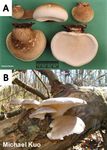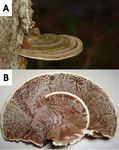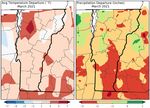Vermont Forest Health - Insect and Disease Observations - March 2021 - Vermont.gov
←
→
Page content transcription
If your browser does not render page correctly, please read the page content below
Vermont Forest Health
Insect and Disease
Observations — March 2021
Department of Forests, Parks & Recreation
March 2021 vtforest.com
Winter Recap: Weather
Vermonters faced another short
and mild winter of 2020-2021,
compared to years past. From
December 1 to February 28,
state-wide temperatures aver-
aged 22.1°F, which was 0.9 de-
grees colder than the winter of
2019–2020. Average precipita-
tion across the state was 7.87
inches, which averaged 1.7 inch-
es less than last year’s average.
Winter snowfall ranged from 40
inches below normal (dark or-
Average temperature, precipitation and snowfall depar-
ange) to 20 inches above normal
ture from normal. Maps and data: Northeast Regional Cli-
(dark blue).
mate Center.
March of 2021 was colder and dryer
than March of 2020. State-wide tem-
peratures averaged 28.1°F, which
was five degrees colder than March
of last year. Statewide precipitation
averaged 1.43 inches, which was
1.48 inches less than March of last
year.
Temperature and precipitation de-
parture from normal. Maps and da-
ta: Northeast Regional Climate Cen-
ter.Vermont Wildland Fire Season in Review
In 2020, 96 reported fires escaped in Vermont that
burned a total of 133 acres. Compared to the state’s 10-
year average, there were 21% more escaped fires re-
ported in 2020. The number of reported fires that es-
caped from debris burning, campfires, smoking, and
lightning strikes were abnormally high due to very dry
ground fuel conditions. Several fires throughout the
summer and fall
burned below the
surface in the ground
and took extra care
and labor to com-
pletely extinguish.
Debris burning was
the most common
cause of escaped
Distribution of reported escaped fires in 2020 (right)
fires across the state by size in which is consistent
2020. Map and data: FPR Staff. with historical data.
Hemlock Woolly Adelgid Overwintering Mortality
Fifty-one percent of the hemlock woolly adelgids (HWA) examined during the annual winter
mortality survey were dead. Although winter temperatures were only slightly colder than last
year, in March we experienced periods of warming temperatures followed by successive days
of deep freezes. This temperature fluctuation could have contributed to winter mortality by
killing otherwise surviving HWA before they could reproduce. In the past, we have often
found infestations in new locations following years with mild winters and low levels of HWA
mortality. Currently, HWA is primarily found in Windham County, however, it has also been
observed in Springfield and Pownal. 2020 surveys observed the spread of HWA within the
state, with a new infestation
being identified in Weath-
ersfield. Similar to past years,
Vermont as well as nearby
states continue to find HWA
occasionally mixed with elon-
gate hemlock scale.
Assessments of overwintering
mortality in hemlock woolly
adelgid conducted on March
16, 2021, indicated that 51%
of the adelgids had died.Incidental Observations
Springtails, also known as snow fleas (Collembola), have been
observed emerging in large masses throughout the state. These
arthropods are detritivores and microbivores and generally
spend their life in moist soil or litter. Springtails get their name
by “springing ” across the snow using a forked appendage at the
end of their abdomen known as the “furcula”. Although common
and generally unnoticed, during winter months, they can be
more easily spotted as jumping black dots against the white
snow.
Springtails on flagging tape.
Photo credit: FPR Staff.
Many species of spiders overwinter in the leaf litter below the
snow. The snow pack acts like insulation, which can allow spi-
ders to maintain a livable body temperature (above 25°F)
without entering hibernation or dying from the cold. Although
less active during the winter months, spiders will continue to
feed when food such as springtails, are available.
Cheiracanthium mildei, an overwintering spider in
Vermont. Photo credit: John R. Maxwell, BugGuide.
The willow bracket polypore (Phellinus igniarius) is a sapro-
trophic fungus that degrades lignin and cellulose leading to the
white-rot of hardwood trees. The fruiting body that is produced
is a bracket polypore that is hard and wood-like in texture. Un-
like most polypores, this fruiting body is perennial, meaning
the polypore will continue to grow every year. Trees with this
polypore are often favored by woodpeckers because decaying
wood is easier to excavate.
Phellinus igniarius fruiting body.
Photo credit: FPR Staff.
Another sure sign of spring is the emergence of boxelder bugs
(Boisea trivittata). These insects have piercing/sucking
mouthparts that feed on and cause minimal damage to leaves,
branches, and seeds of boxelders, maples, and ash. Although
damage is minimal, this common nuisance pest can be man-
aged by raking up fallen leaves and seeds around buildings
and homes. If already in your home, use a vacuum instead of
squishing them to prevent staining your floors.
Boxelder bug. Photo credit:
Larry McDaniel, BugGuide.Winter fireflies (Ellychnia corrusca) have been reported in sap
buckets in the northern parts of the state in late March. As lar-
vae, this insect feeds on rotting wood and overwinters as adults
in bark grooves. In early spring, adults emerge to feed on flowers
and sap, often falling in sap buckets and becoming a nuisance
pest to sugar makers. Although not a significant stressor to the
forest, this insect has historically been used as a predictor of the
end of sugaring season.
Winter firefly. Photo credit:
JPiolain, BugGuide.
Unusual amounts of conifer branch tips on the ground in
the winter are a sign of red squirrels (Sciurus vulgaris).
They do not hibernate, therefore they need a steady food
supply throughout the winter. Red squirrels prefer conifer-
ous forests utilizing seeds, cones, and buds from spruce,
fir, and hemlock. When food sources become scarce, they
will utilize conifer buds. The squirrels will “prune” off
branch tips, eat the buds and discard the tips on the
ground. As a result of this feeding, the forest floor can be-
come littered with branch tips.
Pile of discarded branch tips.
Photo credit: FPR Staff.
Blister beetles (Meloe americanus) were observed in north-
ern Vermont towards the end of March. These beetles can be
hazardous to livestock and humans and should always be
handled with care. These beetles have a defense mechanism
where they can excrete toxins through their joints which can
cause dermal irritation and
blistering of the skin. Blister Beetle. Photo credit:
Nate Walton, MSU Extension.
Bot canker of oak (Diplodia corticola) was observed in the state for
the first time in Windsor county. This fungal pathogen causes stem
and bole cankers, dieback, and mortality of infected oaks. In se-
vere infections, cankers can be identified by sooty lesions and ex-
truded amber-colored sap. Diplodia spp. are typically opportunis-
tic, and symptoms may be reduced by improving individual tree
health and vigor such as pruning infected branches and properly
mulching urban trees. If you observe these symptoms, please re-
port them to savannah.ferreira@vermont.gov.
Oak infected with Diplodia corticola, showing symptoms
of dieback. Photo credit: FPR Staff.Foraging For Fungi
Birch polypores (Fomitopsis betulina) are a historically
sought-after medicinal and edible polypore. This polypore
matures and sporulates in the fall and persists on dead and
dying birch trees in the winter. This fungus can be identi-
fied by its white to brownish-colored cap with a creamy
white pore surface and white spore print. When ripe, this
polypore is soft and leathery, and becomes corky and hard
with age. This mushroom is highly host-specific to birch
species. In the fall, it is possible to confuse this polypore
with oyster mushrooms (Pleurotus ostreatus) another na-
tive edible fungus. This fungus is a saprotroph and can be
found growing in clumps out of dead or decaying hardwood
trees during the fall and winter months. Its cap is large
and wide, often resembling a fan or oyster shell shape, and
ranges from white to yellow-brown. This mushroom has
gills (not pores) that are decurrent (gills are attached to
and run down the stalk) and gives off a grey to light purple
-grey spore print.
A: Birch polypores. Photo Credit: Richard Nadon, MushroomExpert. B: Pearl oyster mush-
rooms. Photo credit: Michael Kuo, MushroomExpert.
Artist’s conks (Ganoderma applanatum) are another
commonly foraged polypore that can be found through-
out the state on hardwood trees. This mushroom can
be both parasitic and saprotrophic, decaying living sap-
wood as well as degrading lignin and cellulose. The cap
of this fruiting body is furrowed dull-brown to red-
brown with a whitish grey pore surface. It can range in
size between 3-30cm wide and 5-50cm long. This pol-
ypore is a perennial fruiting body and therefore is hard
and wood-like in texture. When fresh, artists can make
impressions on the white pore surface under the cap
that will turn dark brown when the fungus dries out.
Although not a common edible, this mushroom has his-
torically been utilized in eastern herbal medicine.
As with all wild mushrooms, there are risks to eating
and misidentifying them which can be both dangerous
and fatal. Always ensure you have the correct identifi-
A: Artist’s conk. Photo Credit: Bec- cation before consuming any wild edible. The State of
ca MacDonald, Bugwood. B: Bot- Vermont accepts no liability or responsibility for
tom of artist’s conk after impres- the consumption and/or misidentification of any
sions. Photo Credit: Corey Coreor- mushrooms mentioned in this publication.
an.Early Detection Species: Invasive Lesser Celandine
An early growing season standout to watch for is lesser celandine (Ficaria verna). Also known
as “fig buttercup” and “fig-crowfoot”, lesser celandine was introduced to North America as an
ornamental plant. An herbarium sample from the 1860s in Pennsylvania indicates its first rec-
orded escape from the garden. The popularity of this perennial plant as an ornamental per-
haps came from the showy yellow flowers that come up in March and April in New England as
a harbinger of spring. A native plant in Europe, the English poet William Wordsworth even
demonstrates a fondness for lesser celandine in several of his poems.
Lesser celandine can be found in flood-
plain forests, along rivers and lakes,
and in disturbed habitats. The primary
way this plant moves is from the under-
ground growth being spread accidental-
ly by erosion, digging in the area by hu-
mans or wildlife, flooding events, or on
purpose through cultivation. This plant
is a particular threat to Vermont’s rare
natural community of floodplain forests.
Once established, lesser celandine cre-
ates dense mats, excluding all other
vegetation. Its tendency to grow up and
flower in the early spring puts native
spring ephemeral wildflowers up against
a tough competitor for space and re-
sources, and its habit of dying back af- Infestation of lesser celandine on a forest edge.
ter flowering makes the window for Photo credit: FPR Staff.
control extremely short each season.
Although the common name might suggest
it, lesser celandine (buttercup family: Ra-
nunculaceae) is not related to greater cel-
andine (poppy family: Papaveraceae). The
most common look-alike for lesser celan-
dine is marsh-marigold (Caltha palustris),
which is a native plant to Vermont and can
be distinguished most easily by only having
5 petals on its flowers. If there aren’t flow-
ers present, look at the roots – lesser cel-
andine will have tuberous roots and marsh-
marigold does not. The best time to identify
lesser celandine in Vermont is in early to
mid-April, when the flowers appear.
The roots of lesser celandine are tuberous and
easily separate, aiding in the spread of this
plant. Photo credit: FPR Staff.Lesser celandine has dark green, shiny basal
leaves that are heart or kidney-shaped, and
variable in size but small (1.5-3.5” across). The
small flowers have 7-11 petals born on grooved
stalks that stick up above the leaves. Once
flowered, the aboveground growth dies back,
and it persists underground as thick tubers.
While still available as an ornamental plant in
some places, lesser celandine has only been
formally recorded as an escape in Vermont in
2014, with populations now being found scat-
tered across the state. It is present in 27
states, and several Canadian provinces. If you
find lesser celandine growing outside of an or-
namental planting in Vermont, please report it
to VTinvasives. Although this species is not on
the Vermont Noxious Weed Quarantine, nor the
watchlist, its invasive tendencies, and prohibi- Bright yellow flowers of lesser celandine
tion in other states are concerning for the appear above the leaves in early to mid-
health of sensitive natural communities in Ver- April in Vermont. Photo credit: Leslie J.
mont and is why we consider this an early de- Mehrhoff, University of Connecticut, Bug-
tection species. wood.
To learn more about Lesser Celandine, check out these additional resources:
New York Invasive Species Information
National Park Service
Texas Invasive Species Institute
GoBotany – Native Plant Trust
National Invasive Species Information Center
Invasive Plant Phenology
Volunteers are needed to help keep track of invasive plant phenology in order to time man-
agement treatments most effectively. Observations will be made during the growing season
from May—September 2021.
If you are interested in taking part in this project, please contact:
elizabeth.spinney@vermont.gov.
Windsor & Windham Counties…………………………………………… Springfield (802) 289-0613
For more information, Bennington & Rutland Counties………………………………………… Rutland (802) 786-0060
contact the Forest Addison, Chittenden, Franklin & Grand Isle Counties……… Essex Junction (802) 879-6565
Biology Laboratory Lamoille, Orange & Washington Counties………………………… Barre (802) 476-0170
at 802-505-8259 or: Caledonia, Orleans & Essex Counties………………………………… St. Johnsbury (802) 751-0110
Forest health programs in the Vermont Department of Forests, Parks, and Recreation are supported, in part, by the US Forest Service, State and Private For-
estry, and conducted in partnership with the Vermont Agency of Agriculture, Food, and Markets, USDA-APHIS, the University of Vermont,
cooperating landowners, resource managers, and citizen volunteers. In accordance with Federal law and U.S. Department of Agriculture policy, this institution
is prohibited from discrimination on the basis of race, color, national origin, sex, age, or disability.
2021-01You can also read



























































